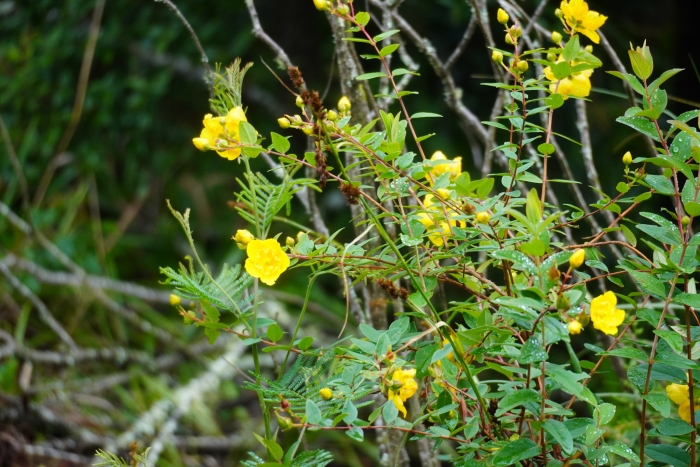Forrest’s St. John’s Wort
(Hypericum forrestii)
Forrest’s St. John’s Wort (Hypericum forrestii)
/
/

Matthew Fainman
CC BY 4.0
Image By:
Matthew Fainman
Recorded By:
Copyright:
CC BY 4.0
Copyright Notice:
Photo by: Matthew Fainman | License Type: CC BY 4.0 | License URL: http://creativecommons.org/licenses/by/4.0/ | Rights Holder: Matthew Fainman | Publisher: iNaturalist | Date Created: 2021-12-23T16:42:18-08:00 |



















Estimated Native Range
Summary
Hypericum forrestii, commonly known as Forrest’s St. John’s Wort, is a semi-evergreen shrub native to the forest margins and open woodlands of Yunnan and Sichuan provinces in China, as well as northeastern Myanmar. It typically grows up to 4 feet tall and wide, with a bushy habit and oval, dark green leaves that turn a striking red in autumn. The plant is adorned with bright yellow flowers featuring prominent, bushy stamens that bloom in late summer, creating a showy display. The bark is not particularly notable, and it does not produce significant fruit or berries.
Forrest’s St. John’s Wort is valued for its vibrant flower color and attractive fall foliage. It is suitable for mixed borders, informal garden settings, and as a specimen plant. This shrub prefers well-drained soil, tolerates a range of soil types including clay, and requires moderate watering with good drainage. It thrives in full sun to part shade conditions. While generally low-maintenance, it can be susceptible to rust and leaf spot diseases. Gardeners should be aware that in some regions, such as the British Isles, it has become invasive. To prevent this, management practices such as deadheading to prevent seed dispersal are recommended. It has earned the Royal Horticultural Society’s Award of Garden Merit for its ornamental qualities.CC BY-SA 4.0
Forrest’s St. John’s Wort is valued for its vibrant flower color and attractive fall foliage. It is suitable for mixed borders, informal garden settings, and as a specimen plant. This shrub prefers well-drained soil, tolerates a range of soil types including clay, and requires moderate watering with good drainage. It thrives in full sun to part shade conditions. While generally low-maintenance, it can be susceptible to rust and leaf spot diseases. Gardeners should be aware that in some regions, such as the British Isles, it has become invasive. To prevent this, management practices such as deadheading to prevent seed dispersal are recommended. It has earned the Royal Horticultural Society’s Award of Garden Merit for its ornamental qualities.CC BY-SA 4.0
Plant Description
- Plant Type: Shrub
- Height: 2-3 feet
- Width: 2-3 feet
- Growth Rate: Moderate
- Flower Color: Yellow
- Flowering Season: Summer
- Leaf Retention: Evergreen
Growth Requirements
- Sun: Full Sun, Part Shade
- Water: Medium
- Drainage: Medium
Common Uses
Bird Garden, Border Plant, Butterfly Garden, Groundcover, Hummingbird Garden, Low Maintenance, Potted Plant, Showy Flowers
Natural Habitat
Forest margins and open woodlands in Yunnan and Sichuan provinces in China, and northeastern Myanmar
Other Names
Common Names: Forrest’s St John’s Wort, St. John’s-Wort
Scientific Names: , Hypericum forrestii, Hypericum patulum, Hypericum patulum f. forrestii, Hypericum patulum var. forrestii,
GBIF Accepted Name: